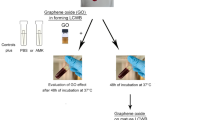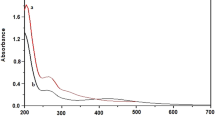Abstract
Biofilm is the consortia of the sessile group of microbial species that are adhered to the biotic and abiotic surfaces with the help of extracellular polymeric substances (EPS) and glycocalyx. A wound is a lesion on the epidermal surface that exposes the underlying tissues to the external environment and thus forms a region of proliferation for several species of Staphylococcus aureus. S. aureus is the most commonly observed nosocomial biofilm-forming organism that is responsible for the development of wound-associated infections. The biofilm prevents the penetration of the drug molecules thereby resulting in the development of antibiotic and multi-drug resistance among the organism. Thus, the use of alternative therapeutics has paved the path in the treatment of biofilm-associated infections. Curcumin has been used for the purpose of treating various illnesses from time immemorial. In this study, we observed that curcumin was able to bring about a reduction in the biofilm formed by S. aureus in the wound infection among the patients. The in silico studies revealed that curcumin possessed the ability to bring about interaction with the biofilm-forming proteins of S. aureus effectively.




Similar content being viewed by others
Data Availability
Not applicable.
References
Lahiri, D., Dash, S., Dutta, R., et al. (2019). Elucidating the effect of anti-biofilm activity of bioactive compounds extracted from plants. Journal of Biosciences, 44, 52.
Chung, P. Y., & Toh, Y. S. (2014). Anti-biofilm agents: Recent breakthrough against multi-drug resistant Staphylococcus aureus. Pathogens and Disease, 70(3), 231–239.
Lahiri, D., Nag, M., Dutta, B., et al. (2021). Catechin as the most efficient bioactive compound from Azadirachta indica with Antibiofilm and Anti-quorum sensing activities against dental biofilm: An in vitro and in silico study. Applied Biochemistry and Biotechnology, 193, 1617–1630. https://doi.org/10.1007/s12010-021-03511-1
Lahiri, D., Nag, M., Dutta, B., Dash, S., Ghosh, S., Ray, R. (2021). Synergistic effect of quercetin with allicin from the ethanolic extract of Allium cepa as a potent antiquorum sensing and anti-biofilm agent against oral biofilm. In: Ramkrishna D., Sengupta S., Dey Bandyopadhyay S., Ghosh A. (eds), Advances in Bioprocess Engineering and Technology. Lecture Notes in Bioengineering. Springer
Lahiri, D., Nag, M., Dutta, B., Dey, S., Mukherjee, D., Joshi, S. J., & Ray, R. R. (2021). Antibiofilm and anti‐quorum sensing activities of eugenol and linalool from Ocimum tenuiflorum against Pseudomonas aeruginosa biofilm. Journal of Applied
Dutta, B., Nag, M., Lahiri, D., Ray, R. R. (2021). Analysis of biofilm matrix by multiplex fluorescence in situ hybridization (M-FISH) and confocal laser scanning microscopy (CLSM) during nosocomial infections. In: Nag M., Lahiri D. (eds), Analytical Methodologies for Biofilm Research. Springer Protocols Handbooks. Springer. https://doi.org/10.1007/978-1-0716-1378-8_8
Soltani, E., Farrokhi, E., Zamanzad, B., Abadi, S. S. M., Deris, F., Soltani, A., & Gholipour, A. (2019). Prevalence and distribution of adhesins and the expression of fibronectin-binding protein (FnbA and FnbB) among Staphylococcus aureus isolates from Shahrekord Hospitals. BMC Research Notes, 12(1), 49.
Rutherford, S. T., & Bassler, B. L. (2012). Bacterial quorum sensing: Its role in virulence and possibilities for its control. Cold Spring Harbor Perspectives in Medicine, 2(11), a012427–a012427.
Jørgensen, N., Zobek, N., Dreier, C., Haaber, J., Ingmer, H., Larsen, O., & Meyer, R. (2016). Streptokinase Treatment Reverses Biofilm-Associated Antibiotic Resistance in Staphylococcus aureus. Microorganisms, 4(3), 36.
Williams, F. N. & Lee, J. O. (2020). Pediatric burn infection. Surg. Infect. 22, 1. Fransén, J. et al. Surveillance of antibiotic susceptibility in a Swedish Burn Center 1994–2012. Burns 42, 1295–1303 (2016)
Ramakrishnan, M., Putli Bai, S., & Babu, M. (2016). Study on biofilm formation in burn wound infection in a pediatric hospital in Chennai, India. Annals of Burns and Fire Disasters, 29, 276–280.
Taneja, N., et al. (2013). Evolution of bacterial flora in burn wounds: Key role of environmental disinfection in control of infection. International Journal of Burn and Trauma, 3, 102–107.
Dutta, B., Lahiri, D., Nag, M., Mukherjee, D., & Ray, R. R. (2021). Introduction to bacterial biofilm and acute infections. In R. R. Ray, M. Nag, & D. Lahiri (Eds.), Biofilm-Mediated Diseases: Causes and Controls. Springer. https://doi.org/10.1007/978-981-16-0745-5_1
Das, M. C., Sandhu, P., & Gupta, P. (2016). Attenuation of Pseudomonas aeruginosa biofilm formation by Vitexin: A combinatorial study with azithromycin and gentamicin. Scientific Reports, 6, 23347. https://doi.org/10.1038/srep23347 Published Mar 22.
Baishya, R., Bhattacharya, A., Mukherjee, M., Lahiri, D., & Banerjee, S. (2016). Establishment of a simple reproducible model for antibiotic sensitivity pattern study of biofilm forming Staphylococcus aureus. Materials Today: Proceedings, 3(10), 3461–3466. https://doi.org/10.1016/j.matpr.2016.10.028
Staats, N., De Winder, B., Stal, L., & Mur, L. (1999). Isolation and characterization of extracellular polysaccharides from the epipelic diatoms Cylindrotheca closterium and Navicula salinarum. European Journal of Phycology, 34(2), 161–169. https://doi.org/10.1080/09670269910001736212
Pereira, S., Zille, A., Micheletti, E., Moradas-Ferreira, P., De Philippis, R., & Tamagnini, P. (2009). Complexity of cyanobacterial exopolysaccharides: Composition, structures, inducing factors and putative genes involved in their biosynthesis and assembly. FEMS Microbiology Reviews, 33(5), 917–941. https://doi.org/10.1111/j.1574-6976.2009.00183.x
Roy, R., Tiwari, M., Donelli, G., & Tiwari, V. (2018). Strategies for combating bacterial biofilms: A focus on anti-biofilm agents and their mechanisms of action. Virulence, 9(1), 522–554. https://doi.org/10.1080/21505594.2017.1313372
Lahiri, D., Nag, M., Dey, S., Dutta, B., Dash S., Ray, R. R. Phytocompounds of Curcuma longa extract are more effective against bacterial biofilm than pure curcumin only: An in-vitro and in-silico analysis. Kuwait Journal of Science
Author information
Authors and Affiliations
Contributions
All authors contributed equally.
Corresponding author
Ethics declarations
Ethical Approval
Not applicable.
Consent to Participate
All authors have their consent to participate.
Consent for Publication
All authors have their consent to publish their work.
Competing Interests
The authors declare no competing interests.
Additional information
Publisher's Note
Springer Nature remains neutral with regard to jurisdictional claims in published maps and institutional affiliations.
Rights and permissions
About this article
Cite this article
Gao, K., Zhang, B. & Zhao, F. Antibiofilm Effect of Curcumin Against Staphylococcus aureus Surface Wound Biofilm–Associated Infection: In Vitro and In Silico. Appl Biochem Biotechnol 195, 5329–5337 (2023). https://doi.org/10.1007/s12010-022-03844-5
Accepted:
Published:
Issue Date:
DOI: https://doi.org/10.1007/s12010-022-03844-5




